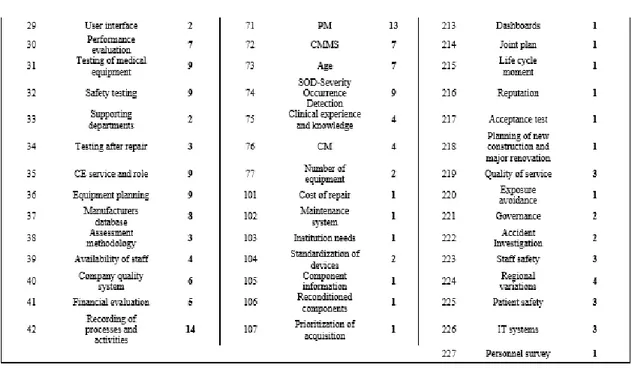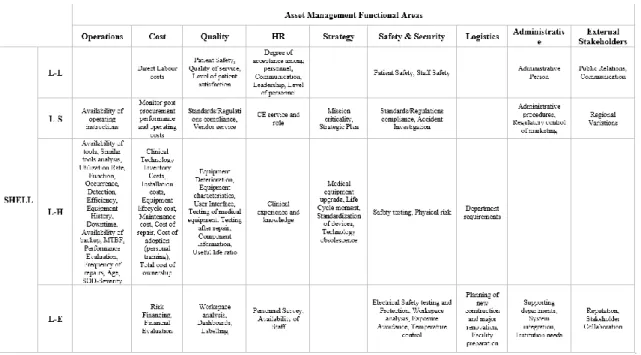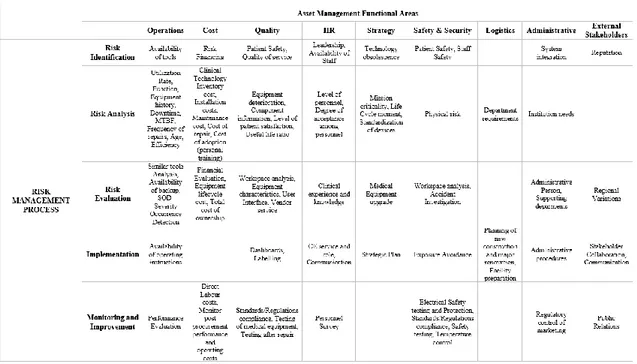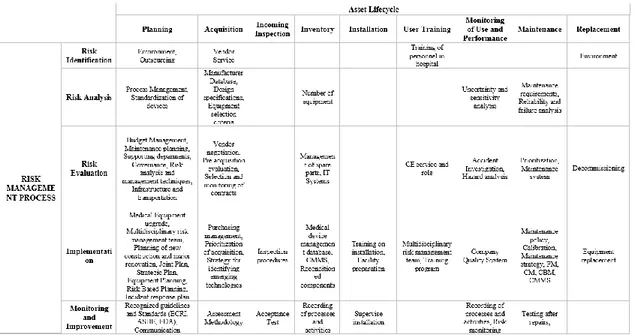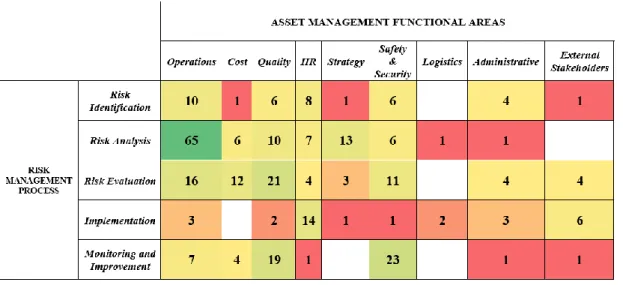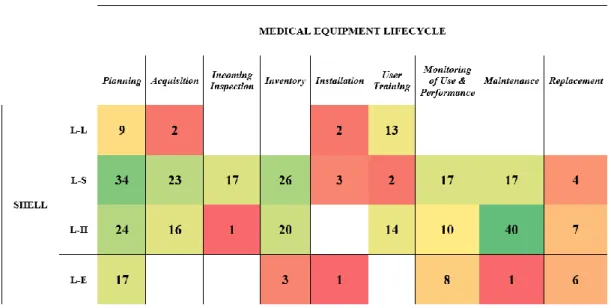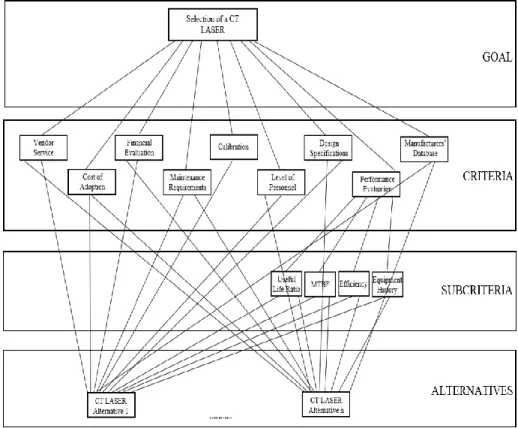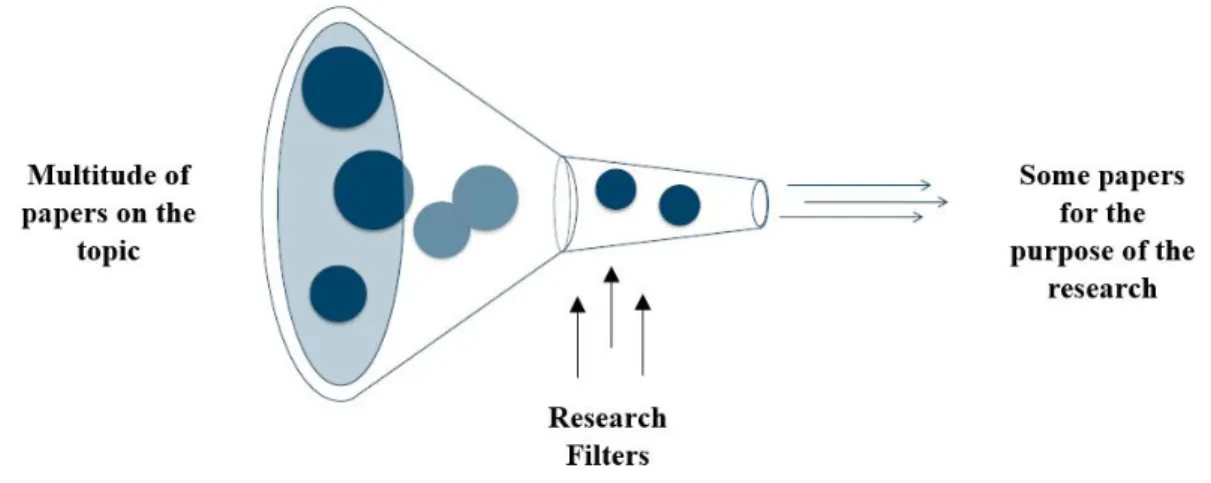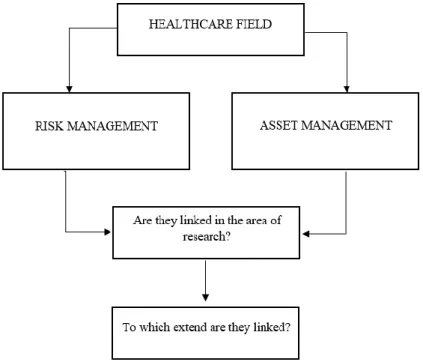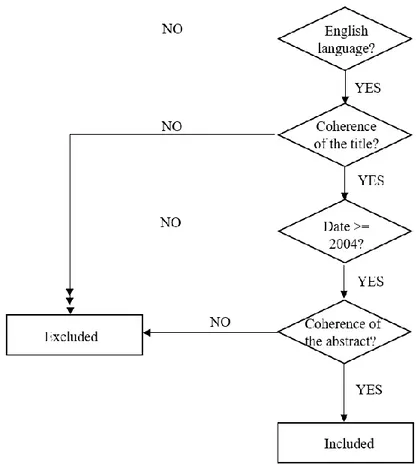POLITECNICO DI MILANO
School of Industrial and Information Engineering
Master of Science in Management Engineering
“Asset Management and Risk Management in
Healthcare: Development of a Decisional
Framework for an Integrated Perspective”
Supervisor: Prof. Paolo Trucco
Graduate Students:
Federico Gattaceca (901629)
Sara Rossetti (901731)
1
ABSTRACT (Italian Version)
Dalla letteratura, molte sono le conferme dell'importanza della gestione del rischio e delle risorse nelle organizzazioni sanitarie. L'attrezzatura medica sta diventando progressivamente sempre più sofisticata, di conseguenza, la sua gestione è una questione fondamentale. Inoltre, poiché le apparecchiature mediche si evolvono continuamente, anche l'impatto sul paziente diventa sempre più significativo. Gestire le tecnologie significa gestire e prevenire i rischi che incidono sul paziente e, come qualsiasi altro tipo di organizzazione, l'ambiente ospedaliero non può essere privo di rischi. Alla luce di queste affermazioni, lo scopo di questa ricerca è di indagare in letteratura lo stato dell'arte, trovando un collegamento tra i due temi. In primo luogo, conducendo una ricerca e una selezione della letteratura, quindi sviluppando una Tassonomia completa e coesa dei fattori, estrapolata dai documenti della letteratura, che incidono sul funzionamento e sulle prestazioni delle apparecchiature mediche; in secondo luogo, creando un Framework che colleghi i due campi. I risultati ottenuti sono sia di tipo qualitativo che quantitativo, mostrando le fasi del ciclo di vita di una risorsa e le aree funzionali della sua gestione che richiedono maggiore attenzione, per quanto riguarda la gestione delle risorse. Per quanto riguarda, invece, la gestione del rischio, vengono fatte le stesse considerazioni sulla interazione componente-componente del modello SHELL e sulla fase del processo di gestione del rischio. La ricerca può essere utilizzata come input per un’analisi di tipo retrospettivo e prospettico. Per quanto riguarda il metodo retrospettivo, analizzando gli errori e impedendone la ricorrenza, mentre per quanto riguarda quello prospettico, anticipando tali errori.2
ABSTRACT (English Version)
From the literature, many are the confirmations of the importance of Risk and Asset management in healthcare organizations. Medical equipment is becoming progressively more sophisticated; as a consequence, its management is a pivotal issue. In addition to this, medical equipment continuously evolves, so the impact on the patient does it too. Managing technologies means managing and preventing risk impacting on the patient, and like any other type of organization, the hospital environment cannot be risk-free. In light of these statements, this research aims to investigate in literature state of the art, finding a link between the two themes. Firstly, conducting a literature search and selection, then developing a complete and cohesive Taxonomy of the factors, extrapolated from literature papers, impacting the functioning and performance of medical equipment; secondly, creating a Framework that links the two fields. The results obtained are both qualitative and quantitative type, showing the steps of the asset lifecycle and the Asset Management functional areas that require more considerable attention from the Asset Management point of view. For what concerns the Risk Management, the same considerations are made on the SHELL model’s interaction component-component and the phase of the Risk Management process. The research can be used as an input for both retrospective and prospective analysis. Concerning the retrospective method, analyzing errors and preventing their recurrence, while concerning the prospective one, anticipating those errors.3
INDEX
ABSTRACT (Italian Version)... 1
ABSTRACT (English Version)... 2
INDEX ... 3 ACRONYMS ... 6 LIST OF TABLES ... 8 LIST OF FIGURES ... 10 LIST OF CHARTS ... 11 0 EXECUTIVE SUMMARY ... 12 Scientific Relevance... 12
Literature search and selection ... 12
Literature Descriptive Analysis ... 13
Factor Analysis Framework ... 14
Analysis ... 20
Conclusion and Future Developments ... 24
1. INTRODUCTION ... 27
1.1. Thesis objectives ... 28
1.2. Studying methodology ... 29
1.3. Thesis structure ... 30
1.4. Thesis results ... 31
2. LITERATURE SEARCH AND SELECTION ... 32
2.1. General Literature Review Framework ... 32
2.2. Specific Literature Review Framework ... 34
2.3. The focus of the review ... 35
2.4. Unit of analysis and database definitions ... 36
2.5. Collection of papers ... 37
2.6. Inclusion/Exclusion criteria definition ... 38
2.7. Screening phase ... 40
2.8. Systematic Literature Review results ... 43
3. LITERATURE DESCRIPTIVE ANALYSIS ... 53
3.1. Medical Equipment Management ... 53
4
3.1.2. The Role of Medical Equipment ... 55
3.1.3. Medical Equipment Management Strategies ... 55
3.1.4. Medical Equipment Management Standards ... 58
3.1.5. Medical Equipment Lifecycle ... 59
3.2. Risk Management papers analysis ... 64
3.2.1. Risk Management in Healthcare Organizations ... 64
3.2.2. Risk Management process ... 65
3.2.3. SHELL Model ... 67
3.2.4. Risk Management techniques ... 69
4. FACTOR ANALYSIS FRAMEWORK ... 71
4.1. Factors Definition ... 71
4.2. Factors Identification ... 72
4.3. Taxonomy ... 73
4.4. Decisional and Performance Factors ... 74
4.5. Framework of analysis ... 80
4.5.1. Asset Management Axis ... 80
4.5.2. Risk Management Axis ... 81
5. ANALYSIS ... 87
5.1. Preliminary Factors Analysis ... 87
5.2. One Dimension Factors Analysis... 94
5.2.1. Performance Factors Recurrence Analysis ... 94
5.2.2. Decisional Factors Recurrence Analysis ... 99
5.3. Integrated Perspective Analysis ... 104
5.3.1. Risk Management Process - Functional Areas Analysis ... 105
5.3.2. SHELL - Functional Areas Analysis... 108
5.3.3. Risk Management Process – Medical Equipment Lifecycle Analysis .... 111
5.3.4. SHELL – Medical Equipment Lifecycle Analysis ... 113
5.4. Potential Methodology Applications ... 117
5.4.1. Retrospective Application... 117
5.4.2. Prospective Application ... 121
5.4.3. Analysis Considerations... 127
6. CONCLUSIONS AND FUTURE DEVELOPMENTS ... 129
APPENDIX ... 133
5 Appendix 2 ... 139 BIBLIOGRAPHY ... 161
6
ACRONYMS
AHP Analytical Hierarchic ProcessAM Asset Management
ASHE American Society for Healthcare Engineering BOL Beginning Of Life
CA Criticality Analysis
CBM Condition Based Maintenance CE Clinical Engineer
CM Corrective Maintenance
CMMS Computerized Maintenance Management System DT Downtime
ECRI Emergency Care Research Institute EOL End Of Life
FDA Food and Drug Administration
IPM Inspection and Preventive Maintenance ISO International Standard Organization
JCAHO Joint Commission on Accreditation of Healthcare Organizations MC Maintenance Cost
ME Medical Equipment
MEMP Medical Engineering and Medical Physics MOL Middle Of Life
MTBF Mean Time Between Failures PdM Predictive Maintenance
PM Preventive Maintenance PP Performance Predictive PV Performance Verification RBM Risk Based Maintenance
RCM Reliability Centered Maintenance RM Risk Management
7 RT Radio Therapy
SJR SCImago Journal Rank indicator SM Scheduled Maintenance
SPI Safety and Performance Inspection SRL Systematic Review Model
8
LIST OF TABLES
Table 1-Executive Summary "Taxonomy" ... 16
Table 2-Executive Summary "Asset Management Functional Areas-SHELL" ... 17
Table 3-Executive Summary "Asset Management functional Areas-Risk Management Process" ... 18
Table 4-Executive Summary "Asset Life Cycle Stages-SHELL" ... 19
Table 5-Executive Summary "Asset Life Cycle Stages-Risk Management Process" ... 19
Table 6-Executive Summary "Risk Management Process-Functional Areas"... 21
Table 7-Executive Summary "SHELL-Functional Areas" ... 21
Table 8-Executive Summary "Risk Management Process-Life Cycle Stages"... 22
Table 9-Executive Summary "SHELL-Life Cycle Stages" ... 22
Table 10 “Source Quality Index” ... 42
Table 11 ”Selected literature Table” ... 52
Table 12 “Taxonomy”... 79
Table 13 "Asset Management Functional Areas - SHELL Table of Factors" ... 82
Table 14 "Asset Management Functional Areas - Risk Management Process Table of Factors" ... 83
Table 15 "Asset Lifecycle - SHELL Table of Factors" ... 84
Table 16 "Asset Lifecycle - Risk Management Process Table of Factors" ... 85
Table 17 “Cumulated Factor Recurrences” ... 93
Table 18 “Risk Management Process - Functional Areas Analysis” ... 105
Table 19 “SHELL - Functional Areas Analysis” ... 108
Table 20 “Risk Management Process – Medical Equipment Lifecycle Analysis” ... 111
Table 21 “SHELL – Medical Equipment Lifecycle Analysis” ... 114
Table 22 “Radiotherapy FM, factors contributing and Cumulated Relevance”... 120
Table 23 “CT Laser Selection Criteria” ... 123
Table 24 "Criteria VS Criteria Matrix" ... 125
Table 25“Performance Evaluation Sub Criteria” ... 126
9
Table 27 "Factors for Papers' Division" ... 138
Table 28 "Initial Factors' Table for Asset Papers" ... 144
Table 29 "Aggregated Factors' Table for Asset Papers"... 147
Table 30 "Initial Factors' Table for Risk Papers" ... 153
Table 31 "Aggregated Factors' Table for Risk Papers" ... 156
10
LIST OF FIGURES
Figure 1-Executive Summary "Legend" ... Error! Bookmark not defined.Figure 2-Executive Summary "AHP Hierarchy" ... 24
Figure 3 “Literature search and review overview” ... 34
Figure 4 “Literature general Framework” ... 35
Figure 5 “Inclusion & Exclusion criteria” ... 39
Figure 6 “Literature review process” ... 42
Figure 7 “Essential elements for life-cycle management of medical devices”. Clinical Engineering Handbook ... 60
Figure 8 “Risk Management process”. ISO 31000 ... 65
Figure 9 “SHELL Architecture”. Human factors engineering in healthcare systems: The problem of human error and accident management ... 68
Figure 10 “Tables’ Legend” ... 105
11
LIST OF CHARTS
Chart 1 “Database Contribution” ... 43
Chart 2 “Keywords Contribution” ... 44
Chart 3 “Per-Year Contribution”... 45
Chart 4 “Research Area related factors” ... 74
Chart 5 “Factors Distribution”... 75
Chart 6 “Asset Management factors redundancy” ... 88
Chart 7 “Risk Management Factors Redundancy” ... 89
Chart 8 “Asset Management Factors Distribution” and Chart 9 “Risk Management Factors Distribution” ... 90
Chart 10 “Factors Recurrence analysis for Asset Management Functional Areas”... 96
Chart 11 “Performance Factors Recurrence analysis for SHELL” ... 97
Chart 12 “Performance Factors Recurrence analysis for Risk Management Process” .... 99
Chart 13 “Factors Recurrence analysis for Asset Lifecycle Phases” ... 101
Chart 14 “Decisional Factors Recurrence analysis for SHELL” ... 102
Chart 15 “Decisional Factors Recurrence analysis for Risk Management Process” ... 103
Chart 16 “Area Relevance Distribution” ... 110
Chart 17 “Area Relevance Distribution” ... 116
12
0 EXECUTIVE SUMMARY
The starting point of the present master Thesis unfolds from the relevance of Asset and Risk Management in healthcare organizations. In particular, managing the operative phase of the life of an asset, intended as medical equipment or machinery, under the lenses of risk.Scientific Relevance
Medical equipment is becoming more sophisticated along time, playing an even more pivotal role. For this reason, its management and, in particular, maintenance are increasing of attention for clinical engineers, practitioners, and stakeholders. Some authors revealed that inadequate maintenance and, more in general, its management are the primary sources of downtime. This latter is only one of the risks for the patient, whose safety is the focus of any healthcare organization. In addition to this, the hospital environment, like any other kind of organization, is not risk-free. So, even if the linkage is implicit, in literature, the gap is on its explicitly, lacking a Framework that combines the two contexts. The actuality and cruciality of the theme underline the relevance of developing research on the topic.
Literature search and selection
A systematic Literature Review is conducted to rigorously and methodologically evaluate the research results. The specific literature review Framework aims at selecting only some papers, for the research, from a multitude of documents on the topic, through the use of research filters.
The focus is, as stated before, on the healthcare field, where Risk and Asset management are treated, and the research questions addressed are the following: “Are they linked in the area of research?”; “To which extent are they linked?”
Defined the topic of the review, the literature search is conducted through the use of science search engines, international bibliographic databases, and specific archives of biomedical and life sciences journals. Through the use of selected keywords, a collection
13 of documents is classified for database, title, author, year, keywords and abstract. Then, through the application of inclusion and exclusion criteria, and a final screening phase of quality of the journal, a total of 37 papers is selected, starting from a total of 153 articles. Results on database, keywords, and per-years contributions are presented at the end of the SLR.
Literature Descriptive Analysis
In this part of the research, the 37 papers are deeply investigated, presenting general summaries of the central Asset management and Risk Management topics, then a general overview on the identification methods of those elements coming from such studies, that represents the basis for the core of the research, is presented.
Starting with the theme of Asset Management, definitions of medical equipment, medical device, and health technology are given and, the role and strategies related to medical equipment are presented too. Furthermore, the description of the stages composing each medical equipment lifecycle is given, as it is the input for the Framework created:
Planning; Acquisition;
Incoming Inspection,
Inventory and Documentation; Installation;
Training of Users;
Monitoring of Use and Performance; Maintenance;
Replacement or Disposal.
Continuing with the part of Risk Management, the section is divided into exposing the theme in these types of organization nowadays: the main trends and findings. Then, offering the concept of Risk management, in particular, its process divided into:
14 Establishing the Context;
Risk Assessment: Risk Identification; Risk Analysis; Risk Evaluation; Implementation;
Monitoring and review.
Then, the SHELL model is presented, as considered an essential pre-requisite for the implementation of a meaningful Risk management approach for the description of a healthcare environment. Its architecture puts the Liveware figure at the center of the model, as our analysis wants to do, putting the patient and its safety at the center of the research. The components are listed below, and their interactions with the Liveware figure compose the model (L-L; L-H; L-S; L-E):
Liveware (L); Hardware (H); Software (S); Environment (E).
Finally, the last paragraph presents the main risk techniques applied in the healthcare field, such as:
FMEA-Failure Mode and Effect Analysis;
FMECA-Failure Mode, Effects and Criticality Analysis; Fuzzy Logic Model;
AHP-Analytic Hierarchy Process.
Factor Analysis Framework
In this section, it is presented more deeply the study performed, starting with the identification of the factors, which are all those elements able to demonstrate a direct impact on medical devices’ performance and functioning. One of the main trends discovered is that a high percentage of factors, extrapolated from the literature analysis of 26 papers over the 37 of the SLR, come from the Middle Of Life phase, or the operative
15 one. For what concerns the 26 papers, they are equally distributed between Risk and Asset studies, in fact, 13 articles come from one theme, and the rest form the other.
Thanks to the identification of factors and their subsequent analysis, classification, and groupage, a Taxonomy is presented, which can offer a more integrated and precise overview of the whole spectrum of factors analyzed:
16
Table 1-Executive Summary "Taxonomy"
Once developed the Taxonomy, factors have been divided into two main categories according to their nature and capability to influence the decisional process:
● Performance Factors: those elements that are possible to be measured accurately at a specific phase of the medical equipment life cycle;
● Decisional Factors: those indicators that do not present a quantitative or analytical approach, or maybe it is not their primary focus; these elements focus more on the strategic and organizational aspects of a situation.
Then, Framework development and explanation are given. It is developed on double-dimension tables, where such double-dimensions are represented on the X and Y axis by Asset Management and Risk Management perspectives, respectively. For each aspect, two different classifications are then presented, to create a more integrated and complete overview of the context. Furthermore, within each table, factors are then classified according to their characteristics.
From the Asset Management point of view, the study proposes two main classifications for factors. The first one provides, for the subdivision of the decisional factors according to the medical equipment, life cycle stages they influence, which have been already
17
presented in the Literature Descriptive Analysis. The second subdivision criteria, from the Asset Management point of view, include a classification of the performance criteria according to the healthcare performance area, the factors are connected with. These functional areas are Operations, Finance, Quality, HR, Strategy, Safety and Security, Logistics, Administrative, and External Stakeholders.
In the Risk Management perspective, factors have been catalogued without distinction between decisional and performance ones. The first one recalls the main steps of a Risk management process for healthcare organizations, and the second one the SHELL model’s interactions among components; presented in the Literature Descriptive Analysis both of them.
Finally, the four tables, filled with the factors taken from the Taxonomy, representing the final results of the Framework, are presented:
18
Table 3-Executive Summary "Asset Management functional Areas-Risk Management Process"
The first two tables above reflect the classification adopted for Performance factors. In both cases, on the x-axis, subdivision according to functional areas is used, while on the y-axis, risk classification firstly follows SHELL methodology and then Risk Management Process steps.
In the next two tables instead, classification performed on Decisional Factors is presented. In this case, on the x-axis, the subdivision, according to ME, lifecycle stages is adopted, while vertically, it follows the two classifications already discussed above.
Such tables will represent the practical standpoints for further considerations in the next steps of the analysis.
19
Table 4-Executive Summary "Asset Life Cycle Stages-SHELL"
20
Analysis
In this section, the main results are shown; the first one is related to the redundancy factors analysis. With redundancy, it is intended the recurrence of factors in other papers, since some of them have been mentioned in literature more than one time. On the one hand, for what concerns the elements coming from the Asset Management papers, preventive maintenance is the factor that appeared the highest number of times followed by downtime of Medical Equipment and training level of personnel. On the other hand, for the Risk Management ones, inspection procedures represent the factor that collects the highest interest, followed by the ability to record processes and activities and to make available equipment history information.
The second group of results is obtained from the analysis of the Framework:
Performance factors recurrence analysis: Operations Area with 32.7% and Quality Area with 18.8%;
Performance factors recurrence analysis for SHELL: Liveware-Hardware with 53.1%;
Performance factors recurrence analysis for Risk Management Process: Risk Analysis with 35.3%;
Decisional factors recurrence analysis: Planning Phase with 24.9% and Maintenance Phase with 17.2%;
Decisional factors recurrence analysis for SHELL: Liveware-Software with 42.4%;
Decisional factors recurrence analysis for Risk Management Process: Implementation with 36.5%.
Then an integrated table analysis is presented to discuss the significant criticalities in terms of individual factors and macro-areas of interest; in fact, the study focuses intensely on the single areas, defined as ‘quadrants”. The approach adopted in this case follows the same of the previous analysis: to evaluate which quadrant has a higher impact on medical equipment’s management-related decisions, factors’ recurrences are considered for ranking areas from the most upper important to the latest.
21
Table 6-Executive Summary "Risk Management Process-Functional Areas"
Table 7-Executive Summary "SHELL-Functional Areas"
The two tables presented above report analysis performed on performance factors previously classified. Colors in the tables reflect the degree of importance each quadrant results to have according to factors within it. Numbers reported represent the cumulated recurrence score of each quadrant, resulting from the sum of the single factors’ relevance contained in it.
22 Then, the following two tables represent the analysis performed on Decisional Factors. Although dimension on the x-axis changes, the analysis follows the same Framework of the tables above.
Table 8-Executive Summary "Risk Management Process-Life Cycle Stages"
Table 9-Executive Summary "SHELL-Life Cycle Stages"
Finally, in the last part of the analysis, potential methodology applications are given. Firstly, the discussed Framework can be used as a standpoint for the evaluation of existing policies and procedures, as a retrospective tool for root causes analysis. In the second
23 instance, the methodology is presented as a reference Framework to develop future healthcare management policies and to prioritize decisions, with prospective purposes. In the first situation, the case study starts from a study conducted in a Radiotherapy and Oncology department in an Italian Hospital by Professor Paolo Trucco, supervisor of this research, and Others. The study is “Applying failure modes effects and criticality analysis in radiotherapy: Lessons learned and perspectives of enhancement”. The Framework proposed will be used as a standpoint to detect possible causes for failure modes among factors evidenced in the Taxonomy. Once identified factors, their classification into this research’s methodology present significant areas of intervention and suggestions for corrective actions.
In the second situation, a potential application of the model is as a reference for supporting the decision about the Selection of a Medical Device used in the Radiotherapy department among different alternatives. In particular, the methodology acts as input for the selection process performed through the AHP. The choice of this application case is due to ensure consistency with the previously analyzed scenario in Radio Therapy and to face the same risks from a different perspective. The “Radiotherapy Risk Profile” reported by the World Health Organization serves as technical support to select which factors to take in higher considerations. The hierarchy is presented below:
24
Figure 1-Executive Summary "AHP Hierarchy"
Furthermore, from the AHP tables, it will be possible to obtain the weights of the alternatives concerning each criterium and sub criterium; in such a way, the final weight for each option can be calculated, and the final decision on the selection of the CT Laser can be taken.
Conclusion and Future Developments
The first conclusion, candidates reached, was the lack of an integrated contribute in healthcare literature able to consider potential risks for patient safety connected with medical equipment management. Such absence remains evident since researches were conducted from both Asset Management and Risk Management perspectives. The second conclusion is about the fact that literature concentrates on the middle of the life of Medical Equipment (73% of its overall contribution). Another miss to be evidenced regards an elaborated Taxonomy able to synthesize potential organizational and operational issues that may affect healthcare activities.
25 In order to overcome those issues, a Taxonomy and a Framework that integrates the perspectives have been created, and the main results obtained are the following:
The main functional area having a direct impact on the outcome of healthcare performances and their possible implications for patient safety is the one of the Operations, 33% of potential risks come from errors or misunderstandings directly in performing routine activities. The other areas that mostly resulted in representing a risk for healthcare organizations are Quality (19%), Safety & Security (15%), and HR (10%). Those having a lower impact are Logistics and External Stakeholders Influence, both with values below 5%;
The lifecycle stage having the highest relevance for the implementation of an effective Asset Management policy is the Planning, almost one-fourth of the overall decisions regarding ME management should be undertaken in this stage. High relevance is also attributed to Maintenance and Acquisition stages, 17% and 12%, respectively;
In general, MOL is confirmed as the medical equipment moment that requires more considerable attention, verifying a trend already existent in literature. However, beginning-of-life activities demonstrated to have a similar impact on the overall performance of ME;
The step of the Risk Management Process with the highest number of factors evidenced in literature is the Implementation phase (37%). Significant influence is also attributed to factors belonging to the Risk Evaluation stage that counts for 27% of the total. Almost the same is the impact of the other three steps (Risk Identification, Risk Analysis, Monitoring, and Improvement), which is stable between 10% and 15% of the total;
The interaction of the SHELL model presenting the highest concentration of factors is the Liveware – Software interaction, 43% of factors concentrate, in fact, in this area. 39% is instead related to L - H relationship, while lower interest is registered by L – L and L – E interactions (8% and 11% respectively).
Table Framework also evidences a more homogeneous distribution of decisional factors influencing patient safety compared to performance factors. In the first
26 case, areas registering a medium-high interest from experts represent 36% of the total, while for performance elements, such value decreases to 22%.
Finally, the application of the proposed methodology in the real case for the Radiotherapy department offered other insights:
The retrospective application allowed the RT department to use Taxonomy developed to perform an in-depth root cause analysis, addressing responsibilities to different areas inside the healthcare organizations. Human Resources area resulted as the department major responsible for mistakes in RT with 35% weight: the absence of practical training sessions for personnel and lack of clinical experience are critical factors for this finding. Quality and Administrative issues also represent fundamental aspects to be managed. The Framework also allowed to rank potential risks for patient safety through a different criticality index; The prospective application results in the development of a prioritization tool for
CT Laser acquisition. The instrument structure follows an AHP approach, whose evaluation criteria have been qualitatively selected among those proposed in the Taxonomy. Manufacturers’ database availability, maintenance requirements, and technical level of personnel resulted in being the most relevant variables to be considered.
Potential further applications of the methodology proposed may result in the adoption of a different perspective in assessing risks for patient safety. A new approach to include medical equipment management in risk evaluations. Moreover, the proposed real case application in RT should be considered as a standpoint for further utilizations in other healthcare departments as an instrument for both retrospective and prospective evaluations. Each healthcare institution may decide to readapt or reallocate factors evidenced to suit its needs better. Excellent adaptability and the possibility for continuous updating are crucial elements that may guarantee future developments to the methodology.
27
1. INTRODUCTION
The present Thesis is intended to investigate the connection between the two macro-areas of “Asset Management” and “Risk Management.” In particular, how one influences the other one in the specific context of healthcare, which is, nowadays, growing faster and faster and is under continuous improvement.
The relevance of these two themes in the field of healthcare is implicit: the output is the service for the patient, whose safety depends, also, on the assets adopted for his care. Assets, which must be managed with rigorous precision and attention, which are under sources of risk in every daily situation: “Organizations of all types and sizes face internal and external factors and influences that make it uncertain whether and when they will achieve their objectives. The effect this uncertainty has on an organization's objectives is “risk.” All activities of an organization involve risk.” (ISO 31000, 2009).
It is of worthwhile importance, for this reason, to introduce the two definitions:
Risk Management: coordinated activities to direct and control an organization with regard to risk (ISO 31000, 2009);
Asset Management: the coordinated activity of an organization to realize value from assets (ISO 55000, 2014).
Before giving other specifications of the present thesis, some milestones must be fixed. The two main themes have been presented, and a definition of each one has been given, the context in which they are treated, too, but the main object in the analysis is still unknown. The candidates have focused the attention on assets, “items, things or entities that have potential or actual value to an organization” (ISO 55000, 2014), but it is reductive to say that in general, the focus is on assets, since the hospital is provided with many types of assets that it would have been too wide to consider all of them.
28 For this reason, it was decided to concentrate on machinery, medical equipment, and technologies with an operative function. This last aspect of the operativity of the asset must be specified. When the topic of Asset Management is considered, a lot of phases and elements must be examined; actually, managing an asset means managing it over different stages of its lifecycle, and about this, it was decided to focus on the management of its middle phase.
1.1. Thesis objectives
All the elements of the object in the analysis are present; the candidates will treat the relationship between the topics of asset and risk management in the field of healthcare, in particular in managing the operative phase of the life of an asset, intended as medical equipment or machinery, under the lenses of risk.
But why this theme has been taken into consideration?
From the literature, many are the confirmations of the importance of the theme. Wang and Rice (2003) have designated the poor maintenance, planning, and more in general management of the medical equipment as the primary source of its downtime. Regarding this, medical equipment is becoming progressively more sophisticated and, consequently, is playing a more pivotal role in the healthcare organizations of these times. As a consequence, its maintenance and management, more in general, are an even more difficult issue to be treated, which is increasing attention for clinical engineers, practitioners, and stakeholders generally (Hamdi et al., 2012). Furthermore, as medical equipment continuously evolves, so the impact on the patient, hospital financial resources and operations do it too. As stated before, the capacity to manage this evolution in the healthcare field is one of the significant challenges in these types of organizations. Managing technologies is challenging in managing risk, too; however, like any other type of organization, the hospital environment cannot be risk-free (Corciova et al., 2013).
In addition to this, nowadays, health companies have to face hard economic conditions, in which managers are forced to use resources in the more productive way possible, exploiting them as much as possible, given the increasing costs and restricted budget.
29 Notably, public hospitals are the ones that are more affected by this situation, and the more the medical equipment resources are better managed, the more the benefits are (Kumru and Kumru, 2013). To cite some benefits, they are the improved financial performances, informed asset investment decisions, managed risk, enhanced services and outputs, and others (ISO 55000, 2014).
For all these reasons, for its actuality, for its cruciality and its increasing interest, the theme has been taken into consideration. In particular, the importance of Asset Management in healthcare organizations, described as “the systematic and coordinated practices through which organizations optimally and sustainably manage its assets, assets systems, their associated performance, risks and expenditures over the asset’s life-cycle for the purpose of achieving the organization strategic plan” (Chemweno et al., 2015), must be put in combination with the Risk Management essentiality in mitigating and preventing equipment failures, or equipment related risks.
1.2. Studying methodology
After having exposed the objective of the Thesis, in this paragraph, it will be presented the Methodology. First of all, it will be introduced the methodological approach. Secondly, the methods of data collection will be described, then the methods of analysis, and finally, the candidate will evaluate and justify the methodological choices.
For what concerns the methodological approach, it has been opted for a theoretical approach to the literature. The aim has been to collect papers, that in a second moment , have been investigated theoretically: interpreting, contextualizing, and gaining in-depth insights into the specific concept. However, after the first qualitative method used to approach literature, this latter has also been interpreted quantitatively, trying to highlight the main trends of the topic in the literature. So, the methods of data collection used during the analysis have been Mendeley, the academic, social network to manage the research and Excel. The selection of papers was classified into a table divided into columns used to collect the fundamental notions of each article, as presented in Chapter 2. Proceeding with the third step of the description of the methods of analysis, as introduced before, the
30 candidates categorized and discussed the main topics of the scientific papers taken into study. It has been an analysis of contents, whose objective was to understand the main trends in healthcare about the two fields, trying to find where to cover the present gap, as Chapter 3 will present. In a second moment, the papers have been investigated more deeply, collecting factors contributing to the operative and maintenance phases of medical equipment, and creating a comprehensive view of it through the creation of a Taxonomy. This last point will be presented in Chapter 4, which corresponds to the main body of the Thesis, where the analysis will be treated genuinely.
The reasons behind these choices are the fact that the tools available for the research were databases, such as Google Scholar or Scholar, whose amount of papers reaches large numbers, so thanks to inclusion/exclusion qualitative criteria, it has been possible to reduce the number of them. Then after a qualitative approach to them, this latter has been put beside a quantitative approach to analyze the main trends from a statistical point of view. Moreover, the factors taken from the literature do not have confirmation in reality, however, the fact that a specific element recurs many times, even in different papers, it is a reliable confirmation of the importance of that factor in the reality. In fact, the Taxonomy is put beside an analysis of the recurrence of those factors. In addition to this, the results of the study have been applied to real cases, extrapolated from literature, to confirm the suitability of the investigation from a theoretical point of view.
Indeed, as widely explained the studying methodology approach has been mainly qualitative, but with a substantial contribution of quantitative methods.
1.3. Thesis structure
The objective of the thesis is to investigate the two themes in healthcare organizations in the literature, to have a solid basis for the construction of the analysis. The search and selection of literature papers will represent a crucial point to identify the gap, which connects the two contexts, to study state of the art, and to develop the analysis. From these results, the descriptive literature analysis will be conducted, presenting the main definitions, strategies, techniques, and standards regarding the two topics. Afterward, it
31 will come to the study performed, starting with the factors’ identification and the following classification. Factors’, that have been extrapolated from literature papers, directly impact on medical equipment performances and functioning. So, as mentioned before, this last aspect underlines the firm reliance on the literature search, selection, and subsequent analysis.
From the factors’ classification, a Taxonomy has been created to offer a more integrated overview of the whole collection of factors. Moreover, its development has been the input for the Framework created, which integrates the Asset Management theme with the one of Risk Management. In this way, the gap present in literature can be bridged, and this research can be used as an input for future investigations to increase even more relevance on the topic. Finally, in the last part of the Thesis, two main applications in healthcare organizations will be presented, and conclusive considerations will be developed.
1.4. Thesis results
The results, candidates have reached, are articulated into three different sections. Firstly, findings related to literature analysis, reporting an overview of the current state of the art regarding Asset and Risk management. Secondly, results coming from the proposed Framework of analysis, of both quantitative and qualitative type. Finally, findings emerging from real-case applications of the methodology, extrapolated from the literature.
32
2. LITERATURE SEARCH
AND SELECTION
2.1. General Literature Review Framework
The aim of a Systematic Literature Review (SLR) is to rigorously and methodologically evaluate the research results. Results that are extrapolated from the synthesis of the best quality scientific studies on a specific research question or topic (Kitchenham et al., 2009). The purposes of reviewing the research literature are various, including theoretical background for future research, learning the spaciousness of research on a topic on analysis, or it is carried out to answer practical questions, understanding what the investigation treats on the matter (Okoli and Schabram, 2010). In the specific case, the last one is the objective of the conducted SLR, intending to answer the question, “What is the relationship between asset and risk management in the healthcare field?”. Performing it, it is possible to identify the state of the art of scientific literature in the research field, synthesizing everything into a Framework and underlying possible future paths of further research in those areas where literature lacks.
Fink (2005) defines the literature review as systemic, because of a methodological approach, comprehensive in including all relevant matters, explicit in justifying all the conducted procedures and reproducible, which stands for being replicable by others who would follow, in investigating topics, the same approach.
To cover all the aspects of the research, an eight steps guide has been followed. Each step must be included if the objective is to obtain a robust SLR (Okoli and Schabram, 2010). 1) Purpose of the literature review: identify the goal of the literature review, which must be defined and precise to carry out a proper analysis. In the specific case, the purpose is to identify the relationship that exists between Asset and Risk Management in the healthcare field. In particular, how the practitioners and clinical engineers deal with the
33
management of assets, intended as machineries, from a Risk Management point of view; since the risk would irreparably affect the patient;
2) Protocol and training: in the case of the presence of more than one reviewer, it is fundamental to be aligned and being concordant on the procedure to be followed during the literature analysis, sometimes it is necessary a written and detailed protocol. Considering this case, the steps and procedures have been agreed among the tutors and us throughout a written and precise updating document during the reviews’ meeting;
3) Searching for the literature: explicit description of the literature search details and explanation of how the search was assured. This is done throughout a clear and methodological analysis of the searching for literature, explained in the further paragraphs;
4) Practical screen: this step stands for the screening for inclusion, being explicit in which studies to be considered and which ones to be excluded from the analysis, without any further examination. For what concerns the excluded studies, it must be specified the reasons why they have not been considered. Considering the specific analysis, also the screening phase and the previous step will be further analyzed in detail in the next sessions;
5) Quality appraisal: this step, on the other hand, stands for the screening for exclusion, being explicit identifying and specifying the criteria for which some studies are excluded from a quality point of view, depending on the research methodologies used in the articles and the quality of the source. For this step, it is valid what has been written previously; 6) Data extraction: data extraction is the step after the identification of all the studies to be deeply analyzed. The reviewer must extrapolate the information from each one. This step has been widely carried out also thanks to a deep reading of each article to include the important aspects of the studies;
7) Synthesis of the research: the synthesis is the analysis of the data extrapolated from the studies and combine them through the use of appropriate techniques, either qualitative
34
or quantitative, but also a combination of them. Carried out in the Literature Descriptive Analysis;
8) Writing the review: of course, a fundamental step is the writing of all the aforementioned points in a report. Sufficient details must be included so that the review can be reproduced.
This general Framework of the Systematic Literature Review has been used as a starting point for the specific case. Each step has been covered and treated. In the following paragraph, the Specific Literature Review Framework is treated.
2.2. Specific Literature Review Framework
Starting with the deep procedure conducted to carry out the literature review, the candidates decided to conduct a funnel analysis, as represented in Figure 2.1:
Figure 2 “Literature search and review overview”
Even if it is possible to deal with a multitude of papers, thanks to the infinite sources, it is not also possible to analyze each one in detail. For this reason, it has been decided to apply this technique, through the use of some filters and criteria, to select the papers that best would have described our problem of research.
The following section will discuss more in detail how the literature search has been developed and structured. It is divided into five sections, and the first one clearly states
35 the focus of the review, the second one defines the unit of analysis and the databases or engines used for the literature search. The third section, instead, deals with the collection of papers and how it has been organized and through which instruments. Then the fourth section is about the definition of the inclusion and exclusion criteria and the last one about the final phase of screening, ending up with the total number of peer-reviewed and conference papers, and books’ chapters.
2.3. The focus of the review
In order to address the problem proposed, the Framework presented in Figure 2.2 has been used. The research, in fact, is divided into two main topics: Asset Management and Risk Management. The objective is to find a link, a connection between these two worlds. How they are influenced by each other and connected in the healthcare field. How the assets, intended as machinery, in their operative phase, are managed through the lenses of risk. The importance of the management of the assets, intended in their operative stage, in the healthcare field is obvious, in fact, a lousy control and governance of assets by the organization would permanently affect and injury the patient safety.
36 In the Introduction chapter, it emerges the implicit connection between the two research fields. In particular, as stated in the ISO 55000 (2014), in the Asset management field “Effective control and governance of assets by organizations is essential to realize value through managing risk and opportunity, in order to achieve the desired balance of cost, risk, and performance.” However, this explicit connection must be found and analyzed in the healthcare area, which is in continuous improvement and growth, in order to assure even more safety to patients.
2.4. Unit of analysis and database definitions
After having selected the defined topic of the review, the unit of analysis definition comes. The candidates opted for international scientific papers from journals, chapters of books, or books themselves and documents from international scientific conferences.
The literature search has been conducted through the use of science search engines (i.e., Google Scholar), international bibliographic databases (i.e., Scopus, Web of Science), and specific archives of biomedical and life sciences journals (i.e., PubMed). The results will show a prevalence of articles from the engine Google Scholar and the database Scopus. Some articles were selected from the archive PubMed and none from the database Web of Science. This is because the articles found, in the latter database, were related too much to the biomedical specificities of its practices, avoiding the part of the Asset Management, focusing more on the risk of the procedures. In addition to this, in order to reorganize the significant number of papers, Mendeley has been suggested to be an excellent way to take a trace of all the sources, authors and names of the papers; to share them among the candidates and to restructure the best as possible the literature review.
Moreover, as stated before, the literature search was conducted using several selected keywords. First of all, focusing on Scopus “the abstract and citation database of peer-reviewed literature”, the chosen keywords were “asset* management”, “patient safety”, “risk management”, “healthcare”, “medical device*”, “hospital”, “clinical technology”, “medical equipment”, “medical technology”, in a second moment of the literature search also a more specific focus was followed, through the use of the keyword “risk-based
37
maintenance”. The focus of the analysis is in the management of the operative phase of the assets, avoiding the beginning and the last step of it; otherwise, the literature research would have found a world to discover, too much wide for the unit of analysis. Continuing with the illustration of the keyword’s selection, they have been used in combination with each other through the use of the logic connector “AND” to cover a broader spectrum of the inspection. Examples of them are “patient safety AND asset* management”, “medical device* AND risk management”, or “asset* management AND healthcare”. In addition to this, the “*” was used not to lose the articles containing the keyword in both singular and plural form.
Secondly, through Google Scholar and Web of Science, similar research was conducted, again with a combination of the keywords mentioned above. Finally, when exploring PubMed, since it is already related to the healthcare and biomedical field, the keyword “healthcare” has been avoided because useless for the research.
Overall the research, keywords used have always been matched together in order to have at least one keyword belonging to one of the two main research areas, defined as Risk Management and Asset Management. This decision has been taken to maintain the focus on the two main themes of the research, and to make more accessible further classifications upcoming in the next steps of the study.
2.5. Collection of papers
The collection of documents happened through the use of Mendeley, the academic, social network to manage the research, collaborate and share the work. However, the use of Excel has been fundamental too. In fact, the collection of papers was classified into a table divided into columns used to collect the fundamental notions of each paper:
1) Database, where the scientific, conference paper or book’s chapter was found; 2) Title;
3) Author; 4) Year;
38 6) Abstract, not the entire one but some meaningful sentences to define the precise
content of the selected literature;
In this way, the analysis and the screening phase have been simplified and improved significantly. Moreover, through the use of Excel, it has been possible to elaborate on the statistics about the research.
Furthermore, the candidates decided to conduct a parallel literature search, meaning that both searched for articles and papers, using the keywords as mentioned earlier. Then, after having collected them into a single Excel file, the elimination of the duplicates took place. In this way, a more comprehensive range of papers was possible to be covered.
2.6. Inclusion/Exclusion criteria definition
As widely explained before, the different combinations of the keywords let to a variety of diverse contributions; as a consequence, some criteria of inclusion and exclusion criteria have been defined to select a smaller group of papers but more significant and representative of the focus in the analysis. The sequence of selection of the papers to be put in the Excel File is the following:
1. Language filter; 2. Title Investigation; 3. Date filter;
4. Abstract Investigation;
The first step has been characterized by the decision to select only articles written in English.
The second step was related to the analysis of the titles, considering valid also articles that from their investigation were omitting one of the two fields, asset or risk ones, but not both. In fact, some keywords must be found in the title; otherwise, they were excluded from the papers gathering.
39 Thirdly, the last step was related to the fact of including papers of the previous ten years, to avoid literature too much dated. However, during the literature search, the candidates have found the necessity to add five years more because of the interesting insights of some articles, discovered fundamentals for the review.
Finally, also the abstract investigation has been included to have a more precise idea of the main theme in the analysis in the paper. Excluding, in conclusion, the ones which were far away from the focus of the Thesis.
The following Figure 2.3 shows the steps of the inclusion/exclusion criteria used to obtain the number of papers useful for the literature review:
40
2.7. Screening phase
After this first stage of selection of papers, the candidates ended up with a total of 153 papers classified by database, title, year, author/s, keywords, and abstract. The screening phase took place with the analysis of the papers and their focus on the Asset Management or the Risk management topics, respectively. In particular, from the 153 papers, 70 percent of them derive from the research topic of the “Risk management” and the 30 percent, corresponding to 46 papers, from the one of “Asset management.”
Since the first selection included articles regarding at least one of the two fields of research, two columns have been included in the Excel File, one indicating the link to the Asset Management field and another one for the Risk Management one. At this point in the research, a more detailed analysis has been conducted on each of the 153 papers previously identified. The focus of this step was to verify the coherence of each paper concerning the two main topics of the research, Asset Management, and Risk Management. In particular, by firstly analyzing the documents related to the Risk Management topic, it was verified if also the Asset Management topic was explained within these papers. This first step was performed by searching inside the documents if there were keywords related to Asset Management. Examples of these keywords are “Medical Equipment Management”, “Medical Device”, “Clinical Technology”. At this point, a quantitative approach was introduced by verifying that such keywords were present within the paper in a reasonably significant number. This number has been selected as 5. This step was followed by a qualitative approach, where it was verified that the keywords identified were used in a context useful to pursue the objective of the research. This analysis has been performed by both the candidates independently and, then together if further doubts emerged. If these contexts were considered relevant and consistent with the scope of the research, the papers were definitely included in the analysis. The same analysis has been performed on papers with Asset Management focus, by evidence, in this case, their connection with the Risk Management topic.
The last fundamental step of the screening phase was the check of the quality of the Journal. It was checked through the use of the Journal Rank or SJR indicator Scimago.
41 This has been possible only for the Scientific Journal sources; for the rest of the literature, books, conference papers and peer-reviewed papers, they have been included with a qualitative check. The following Table 2.1 shows the ranking for the Journal whose quality has been possible to evaluate on the Scimago platform. The column “Quality” points out the H value, which is the “Journal’s number of articles (h) that have received at least h citations over the whole period”.
Source Quality
(H index) International Journal of System Assurance
Engineering and Management 18
Quality and Reliability Engineering International 51 International Journal for Quality in Health Care 81 Biomedical Instrumentation & Technology 25 International Conference on Control, Decision and
Information Technologies (CoDIT)
Journal of Clinical and Diagnostic Research 28
Safety Science 90
Industrial and Systems Engineering Research Conference
Applied Ergonomics 84
Journal of Mechanical and Industrial Engineering 13
Applied Soft Computing Journal 110
American Journal of Applied Sciences 38
Archivio Istituzionale della Ricerca Annual International Conference of the IEEE Engineering in Medicine and Biology Society
Journal of Hazardous Materials 235
Journal of Clinical Engineering 11
BMC Medical Informatics and Decision Making 59
Procedia Manufacturing 18
Mobile Networks and Applications 79
Journal of the Operational Research Society 94 Reliability Engineering and System Safety 119 International Journal of Production Economics 155
Journal of Medical System 63
Clinical Engineering Handbook
Journal of Quality in Maintenance Engineering 47 Health Services Administration Commons
42 International Journal of Medical Informatics 93
Congrès International de Génie Industriel 8th International Symposium on Advanced Topics in
Electrical Engineering (ATEE)
Table 10 “Source Quality Index”
So, from the 33 percent of papers corresponding to 51 of the total number, 37 of them have been selected after this last step of journal quality check, excluding a total of 14. These are, among papers and book chapters, the ones used for the literature analysis. The resuming scheme is shown in Figure 2.4.
43
2.8. Systematic Literature Review results
It has been fundamental to understand the contributions coming from the 37 selected papers. As the first remarkable point, it was analyzed the database and the research engine, which has contributed the most to the literature review. As it is shown in Chart 2.1, Scopus, “the largest abstract and citation database of peer-reviewed literature,” contributed the most to this review, with the highest percentage of 73, providing to the candidates the highest amount of scientific papers and book’s chapters. The 22 percent of scientific papers have been found on Google Scholar and only two, one scientific and one conference papers, on PubMed.
Chart 1 “Database Contribution”
Continuing with the analysis, the candidates wanted to understand also the keywords which contributed the most to the collection of papers, useful for the review. Investigating the Chart below, the combinations of keywords, which showed to be more comprehensive of the topic, have been “medical device* and asset* management” and “medical device* AND risk management”, with respectively 5 and 6 papers found. A good percentage of 11 each, thanks to the contribution of the combined keywords of “medical equipment AND asset* management”, “medical equipment AND risk management” and “risk-based maintenance AND healthcare”. A total of 3 articles were found with the use of “patient
8 2 27 0 5 10 15 20 25 30
Google Scholar PubMed Scopus
N um be r of P ape rs
Databases/Engines Contribution
44 safety AND asset* management”. In addition, 20 percent of the articles were found through the utilization of the combinations “asset* management AND hospital”, “medical equipment AND risk-based maintenance”, “medical technology AND asset* management” and “risk management AND healthcare”. Finally, the last three papers with the remaining combinations. Specifically, the candidates decided to use many combinations to cover the broader range as possible of the review, in order to avoid the excluding of some articles.
Chart 2 “Keywords Contribution”
The last aspect being analyzed has been one of the years of publication. As mentioned before, it was decided to consider literature with a date of publication of a maximum ten years ago, due to the fact that the candidates want to provide a more recent analysis of the discussed topic, avoiding too old concepts. However, it was realized the necessity to include five years more because of the interesting themes developed in older papers and book chapters. In general, as clearly visible in Chart 2.3, the papers are approximately
0 1 2 3 4 5 6 7 N um be r of pa pe rs
Keywords Contribution
45 spread out all over the years, apart from the 2012 and 2018, in which five papers each have been published in those years.
Chart 3 “Per-Year Contribution”
Here is reported the complete Table with all the 37 selected articles used for the Literature review, categorized into “Succession Number, Website source, Title, Author, Year of publication, Source of the Journal/Book/Conference, Keywords used for the research”:
No. Website Title Author Year Source Keywords
1 Scopus A risk-based maintenance approach for critical care medical devices: a case study application for a large hospital in a developing country Vala, S., Chemweno, P., Pintelon, L., & Muchiri, P. 2018 Internationa l Journal of System Assurance Engineering and Management risk management AND hospital 0 1 2 3 4 5 6 Year 2004 Year 2005 Year 2006 Year 2007 Year 2008 Year 2010 Year 2011 Year 2012 Year 2013 Year 2014 Year 2015 Year 2016 Year 2017 Year 2018 Year 2019 N um be r of P ape rs
Years Contribution
46 2 Scopus Reliability analysis of maintenance data for complex medical devices Taghipour, S., Banjevic, D., & Jardine, A. K. S. 2011 Quality and Reliability Engineering Internationa l medical device* AND asset* management
3 Scopus Failure mode
and effects analysis applied to the maintenance and repair of anaesthetic equipment in an austere medical environment Rosen, M. A., Lee, B. H., Sampson, J. B., Koka, R., Chima, A. M., Ogbuagu, O. U., … Jackson, E. V. 2014 Internationa l Journal for Quality in Health Care medical equipment AND risk management
4 Scopus Assessing Risk
in the Kaiser Permanente Clinical Technology Program Davis-Smith, C. E., Painter, F. R., & Baretich, M. F. 2015 Biomedical Instrumentat ion & Technology clinical technology AND risk management 5 Scopus An Integrated Nine-Step Approach to Managing Clinical Technology Risks Brady, T. C., & Panagiotopoulos, G. 2017 Biomedical Instrumentat ion & Technology medical technology AND risk management 6 Scopus Medical Equipment Management Strategies Binseng Wang; Emanuel Furst; Ted Cohen; Ode R. Keil; Malcolm Ridgway; Robert Stiefel 2006 Biomedical Instrumentat ion & Technology medical equipment AND asset* management 7 Scopus Medical Device Risk-Based Evaluation and Maintenance Using Fault Tree Analysis W. P. Rice 2007 Biomedical Instrumentat ion & Technology medical device* AND risk management
47 8 Scopus Multicriteria decision making for Medical equipment maintenance: Insourcing, outsourcing and service contract M. Masmoudi, Z Houria, F. Masmoudi 2014 Conference Paper medical equipment AND risk management 9 Google Scholar Factors Affecting Medical Equipment Maintenance Management: A systematic review R. Bahreini,L. Doshmangir, A. Imani 2018 Journal of Clinical and Diagnostic Research medical equipment AND risk management 10 Google Scholar Human reliability assessment for medical devices based on failure mode Qing-Lian Lin, Duo-Jin Wang, Wen-Guang Lin, Hu-Chen Liu 2012 Safety Science medical device* AND risk management 11 Google Scholar Medical devices Inspection and Maintenance A. Samira, A. Rahimi, D. Ait-kadi 2014 Proceedings of the 2014 Industrial and Systems Engineering Research Conference medical device* AND risk management 12 Scopus A comprehensive fuzzy risk-based maintenance framework for prioritization of medical devices A. Jamshidia, S. A. Rahimia, D. Ait-kadia 2015 Congrès Internationa l de Génie Industriel medical device* AND risk management 13 Scopus QFD: a methodologica l tool for integration of ergonomics at the design stage
Jacques Marsot 2005 Applied
Ergonomics
risk management
AND healthcare
48 14 Google Scholar Building Medical Devices Maintenance System through Quality Function Deployment Adnan Al-Bashir, Mohammed Al-Rawashdeha, Rami Al-Hadithia, Ahmed Al- Ghandoora, Mahmoud Barghashb 2012 Journal of Mechanical and Industrial Engineering medical device* AND asset* management 15 Google Scholar Fuzzy FMEA application to improve purchasing process in a public hospital Mesut Kumrua, Pınar Yıldız Kumru 2013 Applied Soft Computing Journal asset* management AND hospital 16 Google Scholar A Hybrid Decision-Making Model for Maintenance Prioritization in Health Care Systems Hassana Mahfoud, Abdellah El Barkany and Ahmed El Biyaali 2016 American Journal of Applied Sciences asset* management AND hospital 17 Google Scholar Comprehensiv e Frameworks for Decision-making support in Medical Equipment Management Neven Saleh Khalil Saleh 2014 Archivio Istituzionale della Ricerca medical equipment AND asset* management 18 PubMed Medical Technology Management: From Planning to Application Y. David, E. G. Jahnke 2005 Annual Internationa l Conference of the IEEE Engineering in Medicine and Biology Society medical technology AND asset* management 19 Scopus Elements of risk assessment in medical equipment Corciova, C., Andritoi, D., & Ciorap, R. 2013 8th Internationa l Symposium on Advanced Topics in Electrical Engineering (ATEE) medical device* AND risk management
